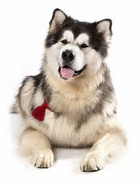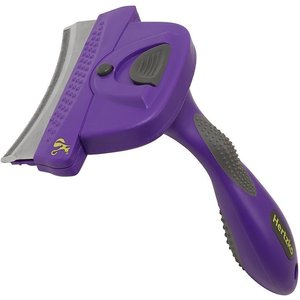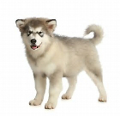
Alaskan Malamute pros and cons
Owning a Malamute dog breed has advantages and challenges. Alaskan Malamutes are active dogs with high endurance and require energetic owners who can take this large dog for long walks and other activities during the day. Malamutes have a warm double coat which is an advantage in cold climates. Malamutes enjoy cool weather and are more appropriate for cooler climates. Alaskan Malamutes enjoy spending time outdoors and having a home with a large yard is a must for this dog.
Cons associated with Malamutes include the dog's large size - this breed is not recommended for apartment living. Alaskan Malamutes have maximum exercise requirements. Malamutes have plenty of energy that needs to be released and keeping the dog in a small apartment in the city is not a good idea as this breed requires plenty of exercise during the day. Malamutes love to bark, which is another reason why Malamutes belong to the more suburban areas rather than big cities. Other challenges with owning a Malamute include the dog's warm coat. In warmer climates Malamutes can get overheated easily. Malamutes have an impressive amount of shedding and owners need to be prepared to spend a considerable amount of time caring for the dog's coat that needs regular brushing, especially during the heavy shedding periods. Alaskan Malamutes are demanding in terms of attention and need proper training. This dog can be a challenge for novice owners as Malamutes can be dominant in temperament and strong willed.
Alaskan Malamute shedding
Do Malamutes shed? Alaskan Malamutes shed heavily twice a year. Malamute has a thick, dense coat that needs regular grooming. Extra grooming is required when Malamute molts heavily and you will notice that the dog's hair comes out in clumps. Alaskan Malamute requires frequent brushing to prevent mats and tangles from forming. Use a slicker or firm bristle brush daily to keep Malamute's coat in good condition and to minimize the chance of developing hot spots (painful skin lesions) that can form in the matted area. Many owners report successful results with PawsPamper Undercoat Rake. Mats are dangerous for Alaskan Malamutes as in the area where mats are forming the skin may get infected with bacteria and fungus.

Fortunately, with the right tools even a heavy shedding is manageable. Brushing your Malamute outdoors is a good idea because you will be surrounded by a cloud of the dog's hair that will fly in all directions. Clean up is much easier when the dog is brushed outdoors.
Alaskan Malamute size
Alaskan Malamute weight:
Alaskan Malamute male weight: 36 to 37 kg (80 to 83 lb)
Alaskan Malamute female weight: 32 to 34 kg (72 to 75 lb)
Alaskan Malamute sizes:
Alaskan Malamute male height: 60 to 63 cm (24 to 25 in)
Alaskan Malamute female height: 55 to 58 cm (22 to 23 in)
Alaskan Malamute coat: thick double coat
Alaskan Malamute colors: varied
How many puppies do Alaskan Malamutes have?
Alaskan Malamute litter size: 4 to 10 puppies
Malamute lifespan:
Alaskan Malamute life span: 12 to 16 years
How much does an Alaskan Malamute cost?
Alaskan Malamute price starts at $900 and up depending on many factors
 Alaskan Malamute temperament
To be a successful sled dog such as Alaskan Malamute, the breed needs certain physical characteristics that include a large size, great strength and endurance. The thick, waterproof double coat of your Malamute is perfect for keeping the dog warm even during the coldest Arctic nights. Alaskan Malamutes have broad, bear-like paws that act like snowshoes in snow, spreading the weight across the paw to keep it from sinking into the snow. This breed can survive in extremely cold temperatures. This dog breed is most comfortable in cool and cold climates and may not be suitable for hot and humid zones. This impressively strong breed needs a significant amount of daily exercise and if you are planning to own Alaskan Malamute, be prepared to spend an hour or two every day keeping your dog active. Alaskan Malamutes need at least a 4 mile (6 km) brisk walk daily - these strong working dogs are built for active lifestyle and do best with an energetic owner who is willing to spend hours outdoors with the Alaskan Malamute every day in any kind of weather.
Bred to work within a pack, the Alaskan Malamute gets along well with other dogs, provided that the dog was socialized from the young age. Are Alaskan Malamutes good with kids? Not recommended for families with toddlers or young children. As with any large breed, Malamute should not be left unsupervised with young children. This breed can be an excellent family dog for active families with older kids.
Alaskan Malamute is the largest of Arctic breeds and males can weigh around 83 pounds and can be as tall as 25 inches at the shoulders. The Alaskan Malamute size requires plenty of area for the big dog to live comfortably. A good size yard comes in handy. The dog will enjoy spending time outdoors. Alaskan Malamute need enough mental and physical activity during the day to keep the dog busy. A bored Malamute is a recipe for trouble, which is a con to owning this breed. This holds true especially for Malamute puppies. The dog may find ways to keep himself busy and can easily damage furniture or find other undesirable ways to stay entertained. Alaskan Malamutes are not suitable for living in a small apartment in the city - the large and active dog needs space and a job to do to stay mentally and physically fit.
Alaskan Malamute grooming
Use a nail clipper for large breeds to cut your Malamute's nails once the nails get long. If you can hear your dog's nails clicking when the dog is walking on the floor, it's time to have his nails trimmed. Nails that grow out too long can grow into the dog's flesh, causing pain and affecting Malamute's posture.
Brush your Malamute's teeth daily. Brushing your dog's teeth regularly helps to remove plaque on his teeth. If plaque is not removed, it will eventually turn into a yellow crust on the dog's teeth that is difficult to remove. Start brushing your dog's teeth at a young age. Provide the dog with dog dental chews that will help to keep Alaskan Malamute's teeth clean. Use canine toothpaste as toothpastes made for humans aren't safe for dogs. Get a long-handled toothbrush for dogs or get one of the toothbrushes that fits over your finger.
Thick coat around the ear area may trap moisture and cause ear infection. If you notice that the ears are sensitive to the touch or the dog is rubbing or shaking his head these are all signs of potential ear infection. Take your dog to the veterinarian if you are noticing any of these signs. To minimize the risk of ear infections be sure to wipe your dog's ears with clean, dry towel after swimming or bathing to prevent moisture from accumulating and creating favorable conditions for ear infections.
Malamutes are best suited for cold temperatures. Here are some tips that will help you to care for your Alaskan Malamute during summer. During hot summer days your Malamute should be kept in cooler areas with shade or in air-conditioned areas.
Walk your dog during the cooler times of the day, such as early morning or later in the evening, when the sun goes down. Protect your dog's paws from getting burned by the hot pavement. Do the "pavement test" before you take the dog outside. Put the palm of your hand on the pavement and if it's too hot for your palm, then it is too hot for your dog's paw to walk on. Walk the dog on the grass instead or wait for the pavement to cool off. In the summer the dog may enjoy running around sprinklers as the water mist will have a cooling effect. Also you can fill up a kiddie pool with water, add some ice there and place it in the shaded area for your Malamute to enjoy a cooling bath. Ice pool is only recommended for the hot summer days. Be sure to provide the dog with fresh drinking water at all times.
Alaskan Malamute puppies
Alaskan Malamute puppy takes about two years to physically mature into a full grown dog. As you are selecting a Malamute puppy, be sure to meet the parents of the puppy. Puppies grow up resembling their parents and you can get a clear picture of how your puppy will look and behave as he matures.
Alaskan Malamute training
Training a Malamute for obedience can be a challenge to Alaskan Malamute owner. Malamutes are not easily trainable - they can be stubborn and an ideal owner should be patient and strong willed in order to achieve good training results. Never use harsh training methods with Malamutes as this will only make training Malamute more difficult.
Alaskan Malamute puppy needs to be trained starting at an early age. Training should start the minute you bring the Malamute puppy into your home. For Malamute's training to be successful, you need to stay consistent. The arctic dog needs to see you as the pack leader. In dog's world the pack leader is the first to enter the home, the first to eat and the one to set rules. Feed your Alaskan Malamute after you and the family finished eating. When entering your home, you should lead the way. Be confident and fair and you will get your Alaskan Malamute's respect from the very beginning of your relationship. Establish rules around the house and be sure that all family members follow these rules. For example, if the dog is not allowed to sleep on a couch, then there should be no exceptions to this rule.
This large breed needs to know the basic obedience commands. Alaskan Malamute training helps to stimulate the dog's mind and teaches the dog good manners. A dog that is well behaved is a pleasant companion for you and your family. Training your giant Alaskan Malamute enables you to have a good control over the dog and keeps him safe. Educate yourself about dog training by reading books on the subject, asking questions and observing dog trainers who are successful at what they do. Use lots of praise and positive reinforcement as you are teaching your Malamute good manners. Use every opportunity for training. You can successfully train a dog of any age, but it is much easier if you start training while the dog is still a young puppy who is more flexible and not yet set in his ways. Older Malamutes can also learn to follow commands, but you will need a lot more patience and time to train an older dog. Make training sessions short and fun for the dog. Reward good behavior and ignore bad behavior. Find out what is the big motivator for your dog. Is it food? Is it play? Or praise? Once you understand what motivates your Malamute, you will have the key to a successful training. Start with one simple command, for example "Sit!" Have your dog standing in front of you. Take a small treat in your hand and slowly move it above the dog's head, towards his ears. Say the word "Sit!" at the same time. If your dog is moving backwards, use the other hand to help him sit down by pressing gently on his back closer to his tail. Or you can have your dog by the wall, where he has to sit down as the wall prevents him from walking backwards. As soon as he sits down, give him the treat and praise him. Remember to praise your dog immediately after a successful command completion. Do not spend more than five minutes on a training session. It is better to have a couple of short training sessions in a day than one long and tiring for your dog. Always end a training session on a positive note. Give your dog a command that he is very familiar with and can successfully execute. Remember to reward him for being good by praise, a small treat or a play. This way your dog will enjoy getting trained and will look forward to the next training session. Socialize your dog early on.
Housetraining your Alaskan Malamute is a priority. Potty training a Malamute is about rewarding good behavior and ignoring accidents that are bound to happen during dog housetraining. Clean up the mess and be on the lookout for the signs of dog's readiness to use the toilet. Malamute will sniff the floor and walk around in circles when he's ready to use a toilet. Immediately take the dog to the designated potty area and praise the dog once he is done. Have a treat handy to reward his good behavior. You may choose to have a word command for potty - choose any word and say it when the dog is doing his business. When you are traveling with the dog or are short on time, the command can be very useful.
A dog crate is an effective housetraining tool when used properly. When a Malamute is crate trained, it is easier to housetrain the Alaskan Malamute. Dogs are den-living animals and once crate trained, many dogs enjoy sleeping in their heavy duty dog crate and hiding their toys or treats there. Never use a crate as a way to punish your dog. His crate is supposed to be his safe area where he can relax and get some privacy. Having your dog crate trained also helps to keep him out of trouble when you are unable to supervise him.
Alaskan Malamute diet
Feed your Alaskan Malamute with high quality, age appropriate dog food formulated for large breeds. Do not overfeed the dog and keep Alaskan Malamute in healthy weight. Overweight dogs are susceptible to different kinds of health issues associated with the extra weight. Fresh drinking water should always be available.
Alaskan Malamute health issues
Alaskan Malamute breed is predisposed to hip dysplasia, which is an inherited disease. Improperly formed joints may lead to arthritis later in life. Dwarfism is another issue that is associated with abnormal growth of cartilage and as a result the dog may have shorter legs than normal. Responsible breeders do not recommend using affected Alaskan Malamutes for breeding. Healthy Alaskan Malamutes and Malamutes that suffer from arthritis enjoy sleeping on a comfortable bed. A dog bed with washable cover is much easier to keep clean.
Bloat can be an issue for Alaskan Malamute breed. Do not overfeed your dog and if you notice any signs of Bloat, take the dog to the veterinarian immediately. Use slow feeder dog bowls to help minimize the amount of air that a hungry Malamute may gulp along with his food.
There are other health issues that can affect Alaskan Malamute that include eye problems, such as progressive retinal atrophy, and this disease causes loss of vision. Cataracts can also be an issue for this breed.
Alaskan Malamute origin
The Alaskan Malamute was recognized by the American Kennel Club in 1935. This breed is believed to be among the very first dogs that accompanied ancient hunters that migrated into the North America about four thousand years ago.
Large dog breeds
Afghan Hound advantages and disadvantages
Akita advantages and disadvantages
American Foxhound advantages and disadvantages
Anatolian Shepherd advantages and disadvantages
Azawakh advantages and disadvantages
Belgian Malinois advantages and disadvantages
Bernese Mountain Dog advantages and disadvantages
Black Russian Terrier advantages and disadvantages
Bloodhound advantages and disadvantages
Borzoi advantages and disadvantages
Bouvier des Flandres advantages and disadvantages
Doberman Pinscher advantages and disadvantages
German Shepherd advantages and disadvantages
Golden Retriever advantages and disadvantages
Great Dane advantages and disadvantages
Labrador Retriever advantages and disadvantages
Rottweiler advantages and disadvantages
Compare large dog breeds
Compare Alaskan Malamute to other dog breeds
Malamute vs Husky
Malamute mixes
Alaskan Shepherd dog
Alusky dog
|